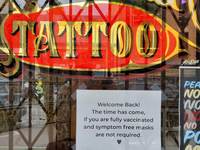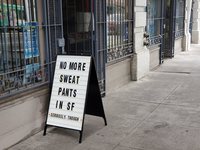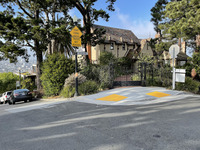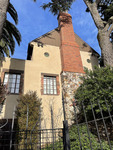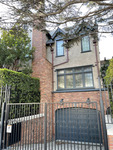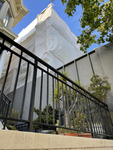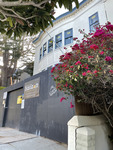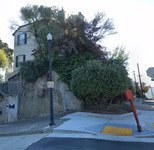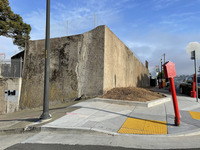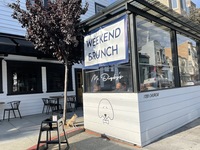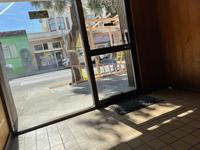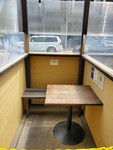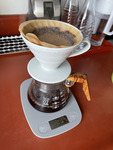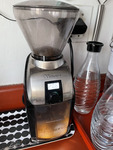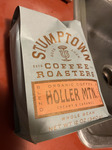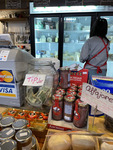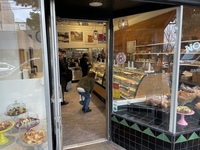 |
| Angelika/Mike Schilli |
Angelika Around May/June 2021, San Francisco awakened from its Sleeping Beauty state. The above average vaccination rate in the city and surrounding county had lowered the incidence count to one-digit values per 100,000 residents. For weeks, the numbers were hovering under 2! Something like euphoria began to develop. Had they indeed beaten the virus? Consequently, on June 15th, all restrictions were lifted, and city life lovers pulled out all the stops. We saw packed restaurants, with tables both inside and outside, and more people not wearing masks, even while shopping at grocery stores. Only the non-vaccinated were required to wear a mouth and nose covering.
Tourists could be seen here and there, and even Downtown San Fransico didn't look as dystopian anymore, slowing losing its ghost town feel. I would meet with selected friends in restaurants, after having not seen them in over a year, and Michael started attending his regular card game one evening. Even Michael's beloved soccer game is now happening regularily again. It is his passion to play every Thursday and Sunday. And we finally got to dine at a restaurant again after a long hike, a tradition we always cherished before Corona. A collective sigh of relief ran through San Francisco and its surrounding counties.
I must admit that, at first, it felt rather strange to take off the mask in public spaces, regardless of vaccination status, especially since I'm used to wearing it throughout the day while working at our school. Also, not everyone was 100% sure what the mandated masking protocol actually looked like, including myself. Store and restaurant owners put up signs to inform vaccinated customers that wearing their mask was no longer required. Alas, no one around here checks customers on their vaccination status at the door. I personally prefer the "trust is fine, but control is better" doctrine, but Americans love their freedom and many see mask mandates as some form of government control over their lives, so stores simply hope that their customers are telling the truth.
In general, I'm rather sceptical that people are willing to take any good advice to heart, and that's why I'm still wearing a mask when I'm inside a store, where I don't know the vaccination status of my fellow humans. It almost seems as if I started a trend here, as many have started wearing masks with the recent events of the delta variant approaching, and infection numbers rising. Even the San Francisco health department has now issued a recommendation to that effect.
Alas, the preventive measures aren't mandatory yet, unlike further south in Los Angeles where mask requirements have returned. No surprise, as San Francisco has stunning vaccination rates, 80% of those who are eligible have already received their first shot, and 70% have been fully vaccinated. And yet, the delta variant is spreading steadily. Infection rates have climbed to double digit numbers, currently they're at 14 per 100,000 residents. But vaccination numbers are growing slower now, even in regions with lower total vaccination rates than San Francisco. In all of California, there's now programs in place to motivate people to get vaccinated. They range from cash payments (50 Dollars), to free tickets to amusement parks, to special lottery drawings for the vaccinated. They're pulling out all the stops!
Since not everyone responds to carrots, there's also stick-based incentives. Many universities in California (e.g. Stanford University, San Francisco State, UC Berkeley) are mandating their students to be vaccinated. London Breed, our mayor, announced, that all 35,000 city employees are required to get the shot. Those who refuse are putting their job on the line. Our school also requires staff to get the vaccine. I support that, having worked through the past school year in fear of getting Covid, or that the virus starts infecting our students. By the way, we managed to get through the year without a single case of Covid in our school, and we we've been continunally open since the fall of 2020. My students are quite excited about getting vaccinated and at the same time sad that the vaccine hasn't been approved for their age group yet. Many anti-vaxxers could learn a lesson from them.
Michael We're regularily watching the "Tagesschau", a daily German evening news show, and can't help but notice that it regularily shows politicians who can't stop complaining about the high cost of housing in Germany. Laughable! Compared to the irrationally fueled real estate market in San Francisco, houses in the most expensive German cities like Munich are still bargains. Granted, the bubble of the Bay Area's and especially San Francisco's housing market has shrunk a bit lately due to residents leaving in droves for more reasonably priced, safer, and more competently governed cities. Lots of tech workers are no longer required to come to the office every day and can work from anywhere, and many a coffee shop milk foamer expert no longer sees a reason for scrounging together exorbitant rent payments every month for a city which has hardly any entertainment options left to offer. That brought a stop to the hyperinflation-style real estate gains recently.
As a side effect, instead of decrepit dumps no one in their right mind would consider buying, there's now a whole lot of really interesting objects on the market. At exorbitant prices, for sure, and they're apparently saturating the market because some of them stay on the listings for months and months with no one willing to take a bite. After all, it'll take a bored billionaire with cash to burn a whole in their pockets to shell out ten million Dollars for such a house.
For example, there's a mysterious, dungeon-like and slightly ugly house at the corner of 21st St and Sanches St for sale now. It once belonged to a former mayor of San Francisco, who, according to rumors, purchased it back in the day for his concubine. I have no trouble believing this, because although the unusually large single family home features a vast dining hall, and plenty of bathrooms, it orginally offered neither a kitchen nor a garage to park a car.
Dot-Com millionaire Frederick Roeber had purchased the house in 2008 for a whopping $4.3M Dollars. The excentric computer nerd, who had worked at Netscape and Google in the early days of the Internet retired in his mid-fourties, and obtained San-Francisco-wide notoriety, because he once hoisted a swastika flag on the roof of his house, oddly, to protest Donald Trump's victory in the presidential election that year. This had in turn upset a neighbor with jewish heritage, and the whole story made the news. Of course the Rundbrief had reported on it back in the day (Rundbrief 12/2016).
Now, Roeber unexpectedly died in June 2020 under mysterious circumstances at the age of 52, and the somewhat crazy house is now on the market, Roeber's heirs are asking $11.9M Dollars. This seems a bit steep to me, but maybe a billionaire without a car who only orders takeout food will snap it up?
While we're on the topic of real estate gossip in our neighborhood: Further down on 21st St, at the corner of Fair Oaks St, there's another building to recently change owners, it's called "Fort Zuckerberg". People here call it that because Facebook founder Mark Zuckerberg purchased the property back in 2014 for the (at the time) absurdly high price of 10 million Dollars (4 million over market price). Back then, local news reported about the subsequent year-long construction, with angry neighbors voicing their discontent about the non-stop construction noise and Zuckerberg's obnoxious 24/7 private security parking and patrolling in the small and otherwise quiet residential street. The article is worth reading, by the way, if only for the fact that the construction included building a "wine room" and a "wet bar".
In the meantime, Zuckerberg seems to have gotten tired of fighting, to simply purchase the properties left and right of Fort Zuck as well, according to rumors at simililarly inflated prices. Likewise, these neighboring houses have been under construction for more than a year now, draped in plastic covers. If you follow along with the gossip on the neighborhood forum Nextdoor, his adjacent neighbors don't seem to mind, probably because their own property values rose abruptly as a ripple effect of Zuck's buying spree. Once the construction noise ceases, they can expect hardly any disruptions, as the Zuckerbergs are practically never in town, living in Palo Alto near the Facebook headquarters, where they purchased no less than four adjacent houses following a similar pattern.
Before you decide to plunge any money into buying an old house in San Francisco, make sure to do your homework and study the quirky process getting permits signed off by the city. According to home owner reports on neighborhood forums, the process can be murky and unpredictable with unexpected setbacks for strange reasons as far as regular Joe Homeowners are involved, yet the rich and famous seem to know how to express-track things in the desired direction. There's stories about home owners having trouble obtaining permits to do simple improvements like remodel the bathroom or fix a wooden deck. City bureaucrats seem to have the power to block any construction, and as a proud new owner of a property you might find yourself sitting on a protected ruin, requiring crazy amounts of money to turn into a livable space.
No such problems seem to have impeded the construction on the corner of 21st St and Sanchez St. According to the city register, the new owner purchased the majestic old building there for the whopping price of 10 Million Dollars, only to have it demolished completely soon after (Figures 10 und 11).
Allegedly, the old house had some structural problems, despite looking okay from the outside. The bulldozers did a thorough job, completely flattening it, and now there's a big empty lot leftover for a spacious new house to be built. Word on the street is it's going to be a multi level monster house, your Noe Valley real estate gossip guy will keep you up to date on any new developments!
Angelika During the pandemic, San Francisco restaurants have gone through tough times, and only as of recently, the few establishments which have kept their doors open, are now starting to thrive again. Many old and established restaurants had to close their doors indefinitely, there's a long list of those. Also keep in mind, that it's actually quite difficult to maintain a steady revenue stream for restaurant owners in San Francisco during normal times, thanks to the competitive environment in such a culinary hotspot. Rents have always been crazy high, and finding qualified staff quite a challenge. Profits are generally minimal, and for a restaurant to survive, it's basically required that they fill every last table, every night.
For many months, restaurants in San Francisco were only allowed to offer takeout an no table service. By Juni 2020, the city permitted serving guests in outside seatings under strict hygienic restrictions. But not every restaurant in San Francisco has outside tables. Very few do, actually, because of the city's windy climate, and even at the end of a sunny day, come nightfall, outside temperatures usally drop to levels too low for sitting outside.
But tough times call for tough measures and the city started to cut through red tape and allowed restaurants to set tables on the sidewalk and even some parking spaces in front of their property, without much bureaucratic rigamarole. As Michael has pointed out here numerous times, cities like San Francisco a rife with unbelievable bureaucratic overhead, and just a few years ago it would have been unthinkable to turn parking spaces or sidewalks into restaurant zones. Hearings, years of endless heated discussions between car haters and residents demanding their parking spaces would have ensued, finally resulting in an inevitable deadlock.
Sure enough, restaurant owners started creating new spaces outside, by cobbling together so-called parklet structures, often crude wooden contraptions to shield the newly set up restaurant tables from the elements and street noise. Now, we have this hodgepodge of new spaces. Some are rather simplistic, others feature elaborate acrylic glass structures, and space heaters for the cold seasons. For example, the restaurant right next to our apartment building, which had changed owners during the pandemic and reopened recently, erected a giant parklet which is very well received by many patrons, right next to our entrance door. People love it to dine there in the evenings, and almost all tables are busy almost every night. Every time we set out to commence our evening walk around the neighborhood, we're walking past diners visibly enjoying themselves.
Since many restaurant owners have invested substantial amounts of money into these structures, and since restaurants have been going through tough times lately, the city councelmen decided to continue allowing those parklets. At first, the parklet permits were temporary, but now they're permanent, and I think it's great, just like having those "Slow Streets" without through traffic (Rundbrief 09/2020), which were also created during the pandemic. Many residents want those to stay as well, and have already launched petitions to cut them into law.
AngelikaIt's not as outlandish as you might think that a seated governor gets recalled before his term is over. Remember 2003, when voters decided that then-governor Gray Davis was to be recalled, and a new round of elections determined that movie actor Arnold Schwarzenegger would be his immediate successor? Now, back then that was indeed the first time something like this had happened in California history.
Although these recalls are commonplace in California, with low barriers to start a new one (Rundbrief 08/2003), they often fail to make it to the actual ballot because either they didn't gather enough signatures, or the signatures gathered can't be verified. Since the 1960ies, frustrated voters have been threatening to recall pretty much every elected governors in office, but so far only Davis actually was recalled.
Now, it's Gavin Newsom's turn, who is our current governor. So far, there had been a whopping five attempts to start a recall, all unsuccessful, but on the 6th try Newsom's opponents managed to collect the required number of valid signatures. On September 14, 2021, all Californians will be able to vote on whether Newsom should stay in office. I think it's all a waste of money. According to the New York Times, the special election will cost taxpayers $276 million. In these times, we really don't need a governor who is distracted from his work by special elections. Corona is still a threat, not to mention the wildfires that are raging all over California again. California is also struggling with a drought again, and we have to save water. Special elections traditionally attract very few voters to the polls, and only mobilize those who want to get rid of the incumbent politician.
Newsom has been in office since January 2019. He belongs to the Democratic Party and made a name for himself as mayor of San Francisco when he allowed same-sex couples to marry spontaneously in the town hall, even though California had not yet allowed it (Rundbrief 03/2004). Governors in California are elected for four years and can serve a maximum of two terms, for a total of eight years.
Everyone knows that Newsom is planning on a carreer in Washington. Some are speculating that he wouldn't be averse to becoming the next President. Now, it's certainly not easy to govern California. The state is not only large, but also populous and an economic superpower, but also plagued by natural disasters such as fires, earthquakes, drought and water scarcity. Newsom probably imagined his term of office to be a bit easier. So far, it has mainly been about crisis management for him.
Because of his Corona related policies, he has come under criticism from his political opponents. California's public schools still haven't fully reopened after more than a year of closure, and the partial lockdowns were not universally accepted. The so-called French Laundry scandal was the tipping point. The French Laundry is a world-famous fine dining restaurant in Napa Valley, with its Michelin star awarded chef Thomas Keller. On November 6, 2020, Newsom celebrated the birthday of a friend, a political lobbyist from Sacramento, at the restaurant, and photos revealed that Newsom was not wearing a mask and the birthday party was inside the restaurant, which was not allowed at the time according to Newsom's own coronavirus regulations. This angered many voters. Newsom already had a reputation as an arrogant, wealthy playboy, and the incident seemed to confirm it.
Over 70 candidates have announced their intention to run against Newsom, most of them from the Republican party. This includes former San Diego mayor Kevin Faulconer, as well as San Diego businessman John Cox. And also Caitlin Jenner, formerly known as Bruce Jenner and married to Kris Kardashian, who became famous through the TV series "Keeping Up with the Kardashians" and winning Olympic gold medals. John Cox stands out in particular, as he is running his campaign with a real bear. His motto is "The Beauty and the Beast". Beauty refers to Newsom, but here it is meant somewhat derogatorily, as a "handsome man". He sees himself as the beast that can beat Newsom. The TV election spots with the bear are so absurd that I always think we are in the wrong movie. Interestingly, Newsom was married to Kimberly Guilfoyle in his first marriage, who is a Republican party member and is now with Donald Trump Junior. Stories like from a Hollywood movie.
Michael Because of Corona, we haven't gone out to eat at a restaurant for a whole year, but one luxury we allowed ourselves at home was good coffee. According to my research, in Germany, any average household owns a space age technolgy coffee machine costing more than a thousand Euros a piece. That's been standard for at least the last 20 years. If you don't have one, you're considered a poor wretch. It's different here in America: the trend is going back to the 60s, and to Grandma's coffee grinder and a porcelain filter attachment, trendily called "V60".
To grind whole roasted coffee beans, we bought the "Virtuoso+" model made by the coffee grinder company "Baratza", which has an Italian sounding name, but actually is American. This model grinds the coffee consistently every time, and won't keep grinding longer if you keep the button pressed, which is common with cheap products. The coffee production must be reliably reproducible, otherwise it's like playing the lottery! By the way, I was told by a trusted resource at my employer that an employee in the coffee kitchen was observed grinding coffee beans during his break with a hand grinder, just like Räuber Hotzenplotz's grandma, for a whopping 10 minutes. He must have written really elegant software afterwards!
Pouring the heated water from the kettle into the filter with the ground coffee is not trivial. In a Youtube video about the coffee filter attachment, British coffee expert James Hoffmann explains that for two cups, you first put 25g of coffee grinds in the filter, then pour 100g of water, then wait 20-40 seconds while constantly shaking the filter attachment until the coffee starts blooming, and finally pour the remaining 350g of water while swirling. You read that right, coffee snobs put the pot with the filter attachment on a digital scale and measure the exact amount of water.
Regarding the beans: For decades we had been drinking imported Dallmayr Prodomo because it was gentle with both of our stomachs and still tasted good. We can no longer tolerate darker roasts, sold in America as "French Roast," but those aren't even popular here anymore. They were for a while, shortly after Starbucks radically changed American coffee habits in an astonishing victory during the 1990s. It replaced the usual dishwater that was created by brewing a teaspoon of powder from the "Folgers" three-kilogram can and taking on a nice malty consistency after sitting on a hot plate for hours. Today, coffee snobs drink milder, lightly roasted varieties, recognizable by lighter beans, but still tickling all taste buds.
Following recommendations from colleagues at work, I ordered coffee beans online from luxury roasters like Little Owl Coffee in Denver or Verve Coffee, a hipster company in San Francisco. The problem with luxury coffee is that you quickly get used to better quality and suddenly regular coffee tastes like slop from a trucker's gas station. But hey, you only live once, life's too short to drink substandard coffee!
Michael After a regular reader based in the Frankfurt area (name known to the editorial team) recently complained that I did not feature a "top product" in the last issue of the newsletter, I am quickly making up for it here. Recently, I got rid of the last two PC towers in our household and switched to Mac Minis, which practically don't need any space because you can drape them under the desk while the keyboard and monitor are on the desk.
Since the memory upgrade was too expensive for me to buy new, I bought cheap 32GB RAM sticks on Amazon and installed them myself. It was a hell of a fun to see the warranty of a newly bought computer go up in smoke! Additional disk space was also too expensive for me, so I bought cheap SSDs, plugged them in and secured them with a wire and two screws under the desk top. In Germany this would be called "Pfusch" ("botch"), but here in America it's quite normal: whatever works, as American say! By the way, the Mac Mini does have a built-in fan, but it's absolutely silent, even when the little all-rounder is pulling out all the stops when rendering videos. In my home office, you'll totally forget that a computer is running and it feels like being in a monastery. Top product!
Audio and video are thus separate, and your main actor often needs several attempts without too many "uhs" before getting it right, so it was worth investing in professional grade video editing software. I got the expensive and complicated Mac program "Final Cut Pro" at a discounted price directly from the factory. The program is very sophisticated, but at the same time so complicated to use that no normal person could make a 10-second video with it. Fortunately, there are thousands of videos on YouTube about how to use the hellish program without going crazy.
It is amazing, and hard to predict in advance, how well homemade videos on YouTube will be received. Despite the elaborate production, the presentation of my baking skills is still languishing in the two-digit views range, such as my video on baking pretzels>or the one on makinghttps://www.youtube.com/watch?v=3ylQG3ig0E0.
I've had much better success on Youtube with my car repair video, where I take apart the center console of our Honda Fit to retrieve Angelika's earring that had slipped down there. Interested hobby car mechanics have already viewed it three thousand times! (Figure 27).
By the way, I learned during my crash course to become a self-proclaimed video wizard why in professional film productions, there's always an assistant with a chalkboard that comes into the picture at the beginning of each scene, and loudly snaps a checkered bar on it, shouting "Scene One!". Turns out that the video and sound of a film are usually recorded separately and then patched together in post production. For my home videos, I often take the image of the cell phone camera or an SLR, whose microphones only produce tinny sound. At the same time, I have a studio microphone record the good sound and the laptop records this to a digital audio file.
Next, a movie editor must piece the film together so that the actor puckers his lips at exactly the moment the "o" sound is heard on the good audio track and there is no shift, as with a bad bootleg. This is an incredibly tedious task that you never quite get right by hand, but this is where the slate comes in: at the beginning of the film scene, the bar visually snaps on the slate and you hear the corresponding click sound on the audio track, also graphically represented as a spike in the editing software - and bam!, you can move both tracks so that the audio spike matches the image of the snapping bar. Everything else then matches up as with an Oscar-winning Hollywood production. Of course, I immediately bought a click slate on Amazon, it only cost 10 dollars. Funny enough, I only found out much later that the editing software "Final Cut Pro" can automatically synchronize a video track with bad audio with a separate audio track recorded by microphone. Times we live in, people!
Michael Do you know what's the most successful newsletter article of all time? It's called "What Germans Do Wrong in America" (Rundbrief 08/2000) and explains the correct tipping etiquette in America. Back then, 21 years ago, I was still upset that German tourists in the US often don't tip enough in restaurants, thus unfairly reducing the wages of the local work force. And to this day, according to Google Analytics, this treatise gets the most hits of the entire site.
Nowadays, the problem has reversed itself, as there are hardly any German tourists anymore, but more and more brazen service businesses in San Francisco are demanding exorbitant amounts of tips. In the traditional tipping establishment, the restaurant, you'll be looked at in disbelief with raised eyebrows if you give the usual amount of 15%, as has been customary for centuries. The waiters, whose service performance has been visibly and steadily decreasing for for years, now want 20%, if not more! Anyone who now shouts "Inflation!" must repeat the percentage mathematics course of their elementary school years, because percentage values do not increase, only the corresponding amounts.
It all started in coffee shops, where "tip jars" are ubiquitous at the checkout. It's customary that cash paying customers, even if they receive no service for "to go" items, have been throwing their change into the jar when they're paying for their coffee latte. This is strange if you think about it. What is this "tip" for? For frothing the milk, pouring the coffee, or ringing up the purchase?
Recently, I entered our new fancy neighborhood fish market around the corner, bought some raw tuna and paid with a credit card, and suddenly a dialogue came up on the terminal, asking if I wanted to give 15, 20 or 25 percent tip. Again: What for? The employee only threw the piece of tuna I pointed to on the scale, typed in the price, wrapped the fish, stuck the label on the packet with the fish and then rang it up at the register. Of course, I entered "no tip", although this seemed cold. But why should the clerk in a trendy fish store earn more than the fish counter man at the supermarket, who does exactly the same type of work?
If you ask around, especially in left-wing strongholds like San Francisco, it turns out that "tip" is nowadays misconstrued as some form of donation for low-wage earners. The millionaire techie thinks, "Oh, the coffee frother at the coffee shop only makes $15 an hour, and I'm filthy rich, so let's throw a dollar in the tip jar, I won't even notice it!" What the generous left lord doesn't consider, however, is that not everyone receives crazy salaries from technology companies shoved up their ass. What if a construction worker wants to treat himself to a coffee, does he then pay with a tenth of his hourly wage for a service that is already included in the purchase price?
It should be noted, though, that fast-food restaurants are the last holdout against this new tipping frenzy. You will never find a tip jar at a McDonald's, Burger King, Wendy's, or In-N-Out Burger. I even read somewhere that the uniforms of McDonald's employees are intentionally made without pockets so that no tips can disappear into them.
The insidious thing about the new behavior is that this "tip" at the credit card terminal often does not go into the pockets of the employees, but is at least partially retained by the operators of the store. So if someone thinks "Okay, I'm rich anyway, I don't care if I pay 20% more" they are signaling to the store that their prices are too low and customers would be happy to pay 20% more. The rich show-off doesn't care if the store then raises the prices, but the clientele who already has to scrimp can then afford even less. So the originally naive-noble intention turns into the opposite: the millionaire socialist drives up prices for everyone, and his protégés in the working class actually suffer from the behavior of their supposed benefactor. The big-headed tip throwers should start thinking about that.
What seems to be completely swept under the rug is what the tip is normally paid for: it is an extra gratuity paid by the guest, to express that they've felt served well at the restaurant. Admittedly, this often requires the waiter to put in some effort, like to quickly ask guests for their wishes when they arrive, perhaps even put on a friendly face, and maybe not chat so engaged with the colleagues behind the counter, getting carried away, and temporarily completely forgetting about their job and the associated tasks, including customers who have been patiently signalling their intention to receive the check for the last ten minutes. A guest that feels exceptionally well cared for will add 20% tip to the bill. In San Francisco, where the typical restaurant bill is around $100, sometimes even $200, this amounts to an extra of $20 of $40 for the waiter per table served, whose base salary is around $20 these days.
What motivation would a waiter have to work a bit harder if the tip was set at a fixed rate of 20% as an added charge to the bill, as some restaurants in San Francisco have already tried? A natural reaction would be to lower the service to the level offered in restaurants in East Germany many years ago. Every restaurant in San Francisco I know that has tried this experiment had to eventually go back to the old system, as customers felt cheated. And rightfully so, it's best to avoid such eccentric places and instead support those restaurants with traditional work ethic.
Another interesting question would be why, for example, a coffee frother in a trendy cafe is rewarded with a tip for their work, while a supermarket cashier is left out of this massive money shower. Wouldn't a supermarket cashier be happy to receive a $15 tip if they checked out a shopping cart with a $100 worth of goods? Or a postman, carrying an Amazon package worth $100, why doesn't he get a $15 tip as a reward? By the way, I worked as a postman many, many years ago and it was not uncommon that someone would slip me a tenner or something. I was always very pleased then, and I didn't interpret it as some form of mandatory levy, but rather as an incentive to next time maybe not crumple the envelope with the glossy calendar into the overflowing mailbox, but instead to ring the doorbell and hand over the valuable piece, despite the loss of time. Money rules the world.
Greetings:
Angelika und Michael



